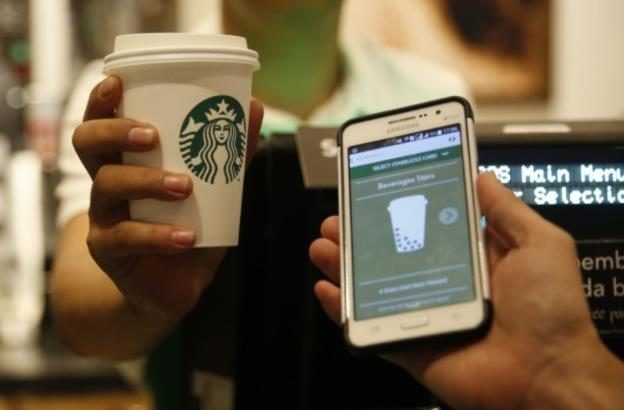Starbucks' action payment strategy has achieved initial results, but it has been downplayed by investors.

For professional baristas, please follow the coffee workshop (Wechat official account cafe_style)
When Starbucks launched online booking and mobile payment services in September 2015, there was a lot of skepticism, when eBay had launched a location-based payment system, and consumers were not very interested. Apple Pay, Apple's mobile payment service, was launched in 2014. It uses NFC, a more secure way to transmit information, but it is difficult to get support from merchants. In promoting mobile payment services, the most successful brand does not come from Silicon Valley, which has the core technology, but Starbucks, a coffee chain with thousands of outlets.
Starbucks' app provides online booking and mobile payment functions, and consumers can book and pay for coffee in nearby stores directly, and pick up cups directly from the store. This service is very popular in the US market and has been widely promoted in the global market. As more and more consumers book in advance and pick up cups at stores, Starbucks is redesigning its store layout to recruit more technical personnel to improve the efficiency of its booking system and payment platform.
In the second quarter of 2017, about 9% of Starbucks orders in the United States were booked in advance, and more than 30% of orders were paid through the Starbucks app, which is much higher than other companies' similar services. Apple Pay is also available in Starbucks stores, but it is rarely used by consumers, with about 5.5 per cent of iPhone users using Apple Pay to pay. Starbucks has changed the way consumers pay in offline stores over the past three years, an achievement that Silicon Valley companies envy.
Online success, but investors don't appreciate it.
Although Starbucks has done well in promoting online services, Wall Street investors are not optimistic about it. The company's share price has fallen 18 per cent in the past two months to its lowest level in five years, mainly due to slower growth in store sales, and investors tend to place too much emphasis on short-term earnings performance and bearish the share price.
Starbucks is well aware of the opportunities that the popularity of smart phones brings to the retail business. Senior Matthew Ryan said that the revenue growth and financial performance brought about by online services will disappoint investors who are bearish on Starbucks, and that e-commerce systems can make Starbucks offline retail stores stand out in an environment where online services impact them, instead of waiting for Amazon to take their business away from them like other companies.
In 2017, the main trend of retail consumption continued to decline, Dick sporting goods store revenue fell 23%; fashion brand Coach revenue fell 15%; e-commerce giant Amazon's market capitalization soared to $105 billion, brick-and-mortar retailers have struggled to compete with e-commerce services. Amazon bought whole Foods for $13.7 billion, which shows that investors are starting to move away from traditional retailing.
But not all traditional retailers whose share prices have fallen are on the verge of being eliminated. The share price of department store Nordstrom has fallen by 50% in the past two years. In 2016, the company's e-commerce platform sales accounted for 50%, and sales increased by 20% in the past three years. However, as the improvement of e-commerce services has not led to a significant increase in total sales, investors are not optimistic about retailers who spend a lot of money to transform e-commerce. The stock price fell as a result of the sell-off.
Starbucks faces the same challenge. The company's sales grew 4% in the second quarter of 2017 compared with the same period in 2016, higher than those of its competitors, but Starbucks investors are used to seeing better results. Worst of all, the company may be withdrawn from its 2021 profit growth guidance of 15% to 20%, which has a huge impact on the stock price.
Use mobile services to enhance consumer loyalty
For Starbucks, mobile services can enhance consumer loyalty and customer unit prices. at present, any user who uses the Starbucks app must register as a member and participate in points activities, which is an important means for the company to promote consumer loyalty. Starbucks customers totaled 75 million in the second quarter of 2017, of which about 18 per cent participated in points activities. These consumers contributed 36 per cent of revenue, and consumer spending per member increased by 8 per cent over the same period in 2016, twice the growth rate of retail sales. In addition to the changes you can see in the results, online services also allow Starbucks to provide personalized services. For example, regular coffee drinkers can get 50 stars when they try other products. This is Starbucks' customer reward system. For every dollar spent, you can get 2 stars and 125 stars for free.
Starbucks hopes to attract more new customers through its online service system and offer more time-and weather-based services, such as discounts on iced coffee in hot weather.
Too many stores? We will continue to open stores in the future.
Wall Street believes that Starbucks' biggest challenge is that there are too many stores, with an average of 3.6 stores within a mile, and the density of Starbucks stores in big cities like New York is even more exaggerated, with 24 stores within a mile. But is Starbucks' store data saturated? Continuing to open new stores is still good for sales, as the market for coffee shops in the United States is far from saturated. Starbucks has a market share of about 64%. Americans drink 400 million cups of coffee a day, and only 5% are Starbucks.
Starbucks plans to increase the number of stores worldwide to 37000 by 2021, an increase of 10, 000 over the current number. About 40% of new stores will be opened in the United States, and 5000 stores will be opened in the Asia-Pacific region. Starbucks revenue growth in this market is as high as 70%.
Howard Schultz, who resigned as Starbucks CEO in April 2017 and is now chairman, told investors that if Starbucks were a 20-chapter book, it would only be Chapter 4 or Chapter 5 when he bought Starbucks in 1987.
Important Notice :
前街咖啡 FrontStreet Coffee has moved to new addredd:
FrontStreet Coffee Address: 315,Donghua East Road,GuangZhou
Tel:020 38364473
- Prev

Afraid of customers being too lonely, Japanese cafes send teddy bears to accompany them. They are so loving.
Professional barista communication Please pay attention to the coffee workshop (Wechat official account cafe_style) Human beings are social animals, so whenever we see someone left alone, we subconsciously feel that he needs care. Eating and traveling alone is a sign of loneliness in the eyes of most people. Some businesses are very considerate when they receive individual customers. Like good.
- Next

10 square meters unmanned coffee shop opens in Beijing for enjoyment and convenience to survive.
Let's have a drink at ▲ Beijing unmanned coffee shop. (photo / photo from Beijing Business Daily) Please follow the coffee workshop (official Wechat account cafe_style). An unmanned coffee shop called Youyin Bar recently opened at the University of International Business and Economics in Beijing. The unmanned coffee shop is located downstairs in Hongyuan, not far from the playground, with an area of about 10 square meters. Two self-service coffee shops are arranged in the coffee shop.
Related
- Stop business for rectification! Jasmine milk white clerk deliberately did not pack and let the rider wait!
- Ridiculous! Tims pressured the federal government to relax the entry of foreign workers?!
- How to judge the brewing method by the state of the powder bed? How to break out of a deep hole with hand-brewed coffee?
- Detailed explanation of the proportion of gold gouache in hand-brewed coffee? What are the Gold Cup Guidelines?
- What is the difference between the gold label rose summer and the red label rose summer in Guixia Village? Are Rose Summer 1931 and Gori Rose Summer?
- Cudi stores ban other brands of coffee?! Netizen: No problem
- Is it better to make coffee cold or hot? Why is it recommended to drink hot coffee?
- Lucky people collapsed! The store ceiling is full of AI surveillance cameras?!
- Law Enforcement Bureau? Mixue Ice City enters Zhengzhou BRT platform!
- Heavy! Nestlé has been exposed to consider selling blue bottle coffee!

